The Singer Sewing Machine 9410 is a versatile and user-friendly sewing machine designed for various sewing projects․ It offers a range of features that cater to both beginners and experienced sewists, making it a popular choice for home and small-scale sewing․ With its compact design and advanced functionality, the Singer 9410 is known for its reliability, efficiency, and ability to handle diverse fabrics and stitching needs․ This manual will guide you through its features, operation, and maintenance to ensure optimal performance and creativity in your sewing endeavors․
1․1 Overview of the Singer 9410 Model
The Singer 9410 is a computerized sewing machine designed for versatility and ease of use․ Weighing just 14․5 pounds, it is portable and ideal for sewing enthusiasts of all skill levels․ The machine features a large LCD screen for easy stitch selection, 100 built-in stitches, and six automatic one-step buttonholes․ With a maximum sewing speed of 850 stitches per minute, it is perfect for both small and large-scale projects․ The Singer 9410 includes an automatic needle threader, a free-arm design, and a sturdy metal frame for durability․ Its intuitive controls and extensive stitch options make it a great choice for quilting, home decor, and garment construction․ This model is well-suited for those looking to combine modern technology with traditional sewing techniques, offering a balance of functionality and creativity․
1․2 Key Features of the Singer 9410
The Singer 9410 boasts an impressive array of features that make it a standout sewing machine․ It includes 100 built-in stitches, offering versatility for various sewing projects, from basic mending to intricate embroidery․ The machine also features an automatic needle threader, saving time and reducing eye strain; A large LCD screen allows for easy stitch selection and customization․ With six automatic one-step buttonholes, creating professional-looking buttons is effortless․ The Singer 9410 also offers adjustable stitch length and width, giving users precise control over their work․ Additionally, the machine includes a free-arm design for sewing cuffs and sleeves and comes with multiple presser feet for specialized tasks․ Its sleek, compact design and lightweight construction make it easy to transport, while the built-in carry handle adds convenience․ These features collectively make the Singer 9410 a comprehensive tool for sewists of all levels․
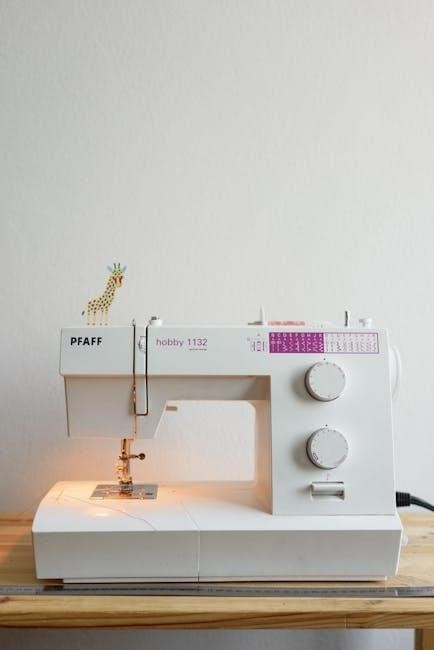
Safety Precautions and Setup
Always follow safety guidelines to avoid accidents․ Ensure the machine is placed on a stable surface, keep loose clothing tied back, and unplug it during setup or maintenance․ Properly unpack and assemble the machine, referring to the manual for guidance․ Use only Singer-recommended accessories to ensure compatibility and safety․ Familiarize yourself with the machine’s components before use to avoid mishandling․ Keep children and pets away while operating; Regularly inspect the power cord and plugs for damage․ Follow these precautions to ensure a safe and efficient sewing experience with your Singer 9410․
2․1 Essential Safety Tips for Using the Singer 9410
- Always keep loose clothing, long hair, and jewelry tied back to avoid entanglement with moving parts․
- Never leave the machine unattended while it is in operation or plugged in․
- Use only Singer-recommended needles and accessories to prevent damage or malfunction․
- Keep children and pets away from the machine while sewing․
- Avoid sewing over pins, as they can cause injury or damage to the machine․
- Unplug the machine before cleaning, lubricating, or performing any maintenance․
- Ensure the work area is well-lit to maintain visibility and avoid accidents;
- Never touch the needle or other moving parts with your fingers or bare hands․
- Follow the manual’s guidelines for threading and operating the machine correctly․
- Store the machine in a dry, cool place when not in use to prevent rust or damage․
By adhering to these safety tips, you can enjoy a safe and efficient sewing experience with your Singer 9410․
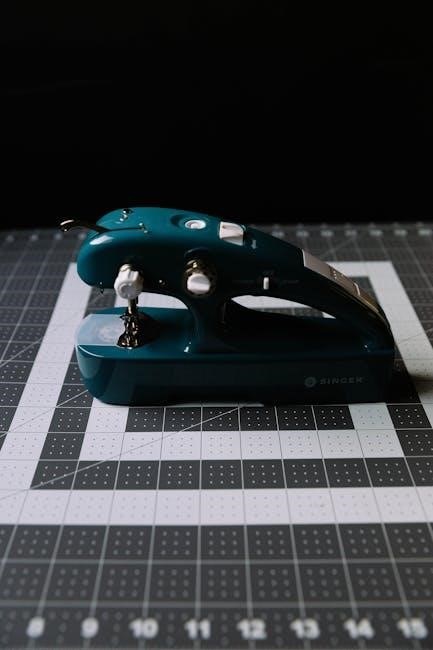
2․2 Unpacking and Initial Setup of the Machine
When you receive your Singer 9410, carefully unpack all components, including the machine, accessories, and manual․ Ensure no parts are damaged during shipping․ Place the machine on a sturdy, flat surface, away from direct sunlight and moisture․ Plug in the power cord, but avoid turning it on immediately․ Familiarize yourself with the accessories, such as presser feet, bobbins, and needles, and store them in a safe place․ Before first use, read the manual thoroughly to understand the machine’s functions and settings․ If included, attach any additional accessories like the sewing table or extension arm․ Finally, test the machine by sewing a scrap piece of fabric to ensure it operates smoothly․ Proper unpacking and setup are essential for a seamless sewing experience․
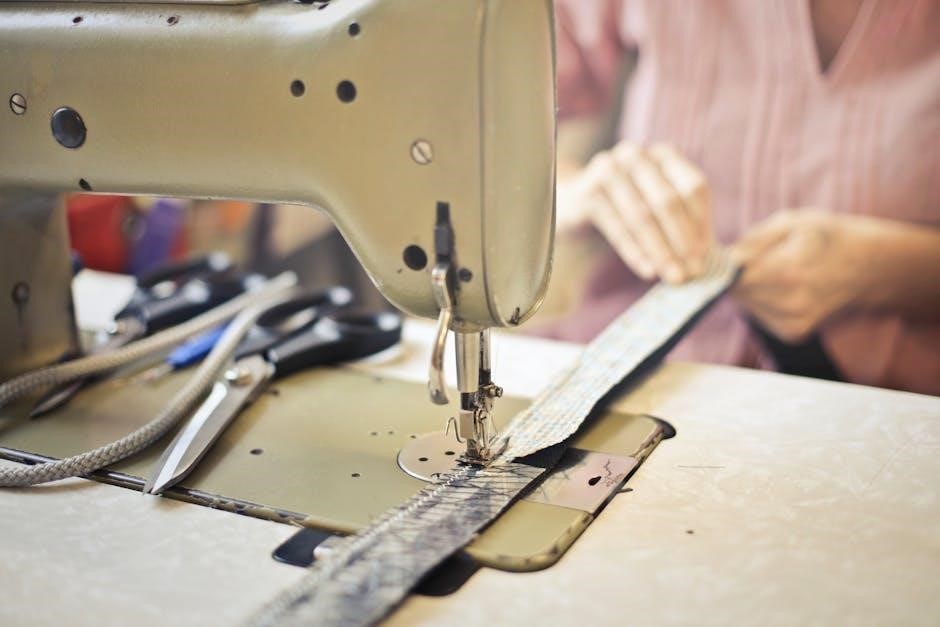
Basic Operations of the Singer 9410
Mastering basic operations is essential for effective sewing․ This section covers threading, bobbin preparation, and stitch selection, ensuring a smooth start to your sewing journey with the Singer 9410․
3․1 Threading the Machine: Step-by-Step Guide
Threading the Singer 9410 is a straightforward process that ensures smooth stitching․ Start by turning off the machine and locating the spool pin․ Pull the thread from the spool and guide it through the tension discs, keeping it taut but not overly tight․ Next, loop the thread around the take-up lever and pass it through the needle’s eye․ Gently pull the thread to secure it․ Finally, trim any excess thread near the needle․ Proper threading ensures consistent stitch quality and prevents machine jamming․ Always use high-quality thread compatible with your fabric type for optimal results․
- Turn off the machine before threading․
- Use the built-in spool pin for easy thread management․
- Keep the thread taut to avoid loose stitches․
TIP: Use the automatic needle threader for quick and precise needle threading․
3․2 Winding and Inserting the Bobbin
Winding and inserting the bobbin is a crucial step for smooth sewing․ Begin by placing the bobbin on the bobbin pin and pull the thread end through the bobbin’s hole․ Hold the thread gently and press the foot pedal to wind the thread evenly․ Stop when the bobbin is about 80% full․ Trim the excess thread, leaving a small tail․ Open the bobbin case and insert the bobbin, ensuring it rotates counterclockwise․ Close the case and pull the thread to seat it properly․ This ensures the machine runs smoothly without tangling or breaking the thread․
- Use the bobbin pin for secure winding․
- Keep the thread taut during winding․
- Ensure the bobbin is correctly seated․
TIP: Always use a bobbin designed for the Singer 9410 for optimal performance․
3․3 Selecting and Sewing with Different Stitch Types

The Singer 9410 offers a variety of stitch types to suit different sewing needs․ Use the LCD screen to select from 100 built-in stitches, including straight, zigzag, decorative, and stretch stitches․ For basic sewing, the straight stitch is ideal, while zigzag stitches are perfect for preventing fraying on woven fabrics․ Decorative stitches add embellishments, and stretch stitches are great for knits․ To select a stitch, press the arrow keys to scroll through options and confirm with the “OK” button․ Adjust stitch length and width using the +/- buttons․ Once selected, test the stitch on a scrap fabric to ensure settings are correct․ This feature allows for precise control over your sewing projects, ensuring professional results every time․
TIP: Experiment with different stitches to enhance your creativity and achieve the desired finish․
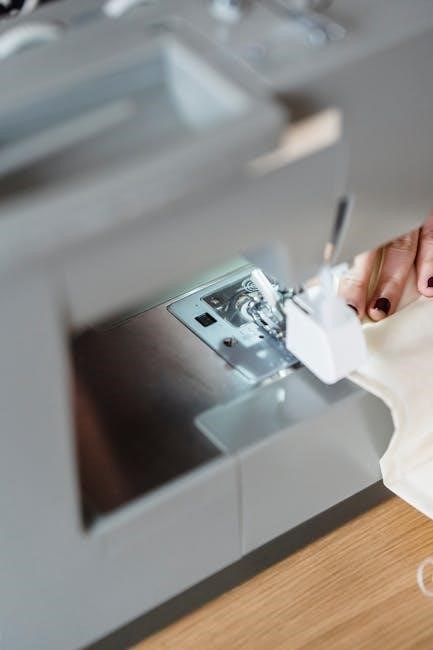
Advanced Features of the Singer 9410
Experience the Singer 9410’s advanced features, including an automatic needle threader, customizable stitch length and width, and an LCD display for easy stitch selection․ These features enhance sewing efficiency and precision, allowing for more complex projects․ TIP: Explore built-in stitches for creative sewing solutions․
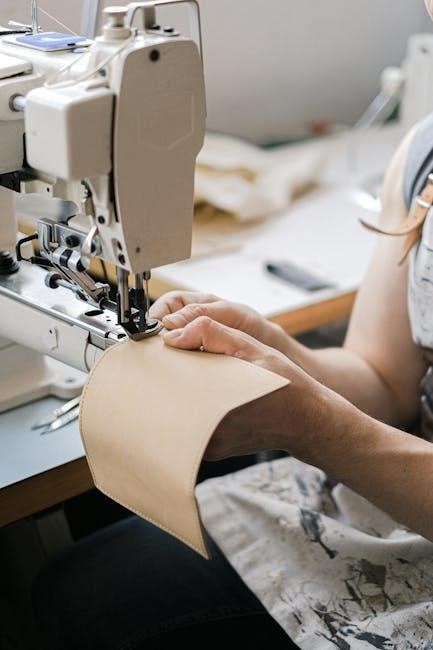
4․1 Exploring the Built-In Stitches and Patterns
The Singer 9410 comes with an impressive array of 100 built-in stitches, offering versatility for various sewing projects․ These stitches are categorized into straight, zigzag, decorative, and stretch stitches, ensuring adaptability for different fabrics and techniques․ The machine also features multiple one-step buttonhole styles, perfect for creating professional-looking buttonholes․ Users can easily navigate through the stitches using the LCD display and corresponding buttons․ TIP: Experiment with decorative stitches to add unique touches to your projects․ The machine’s stitch selection menu is intuitive, allowing seamless transitions between patterns․ Whether you’re working on garments, home decor, or crafts, the Singer 9410’s stitch variety ensures you’re equipped for any task․ This feature-rich design makes it a standout choice for sewists seeking creativity and precision in their work․
4․2 Using the Automatic Needle Threader
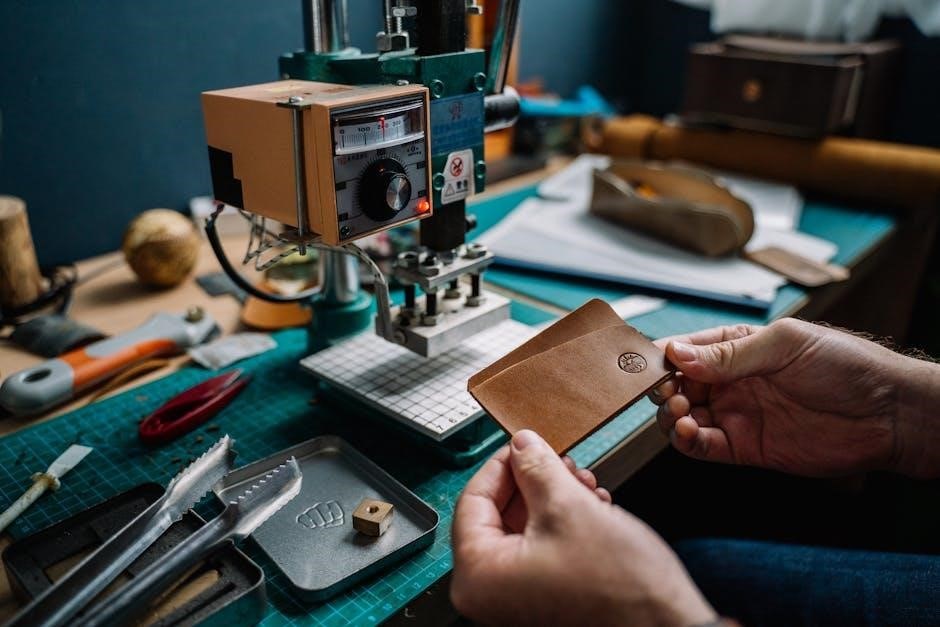
The Singer 9410 features an automatic needle threader, a convenient tool designed to save time and effort․ To use it, simply pull down the threader, loop the thread around the hook, and let the machine do the work․ This feature is especially helpful for users with vision or dexterity challenges․ TIP: Ensure the machine is turned off and the needle is in its highest position before threading․ The automatic needle threader ensures the thread is properly seated in the needle’s eye every time, reducing frustration and improving efficiency․ This feature is a significant advantage for sewists who value ease and precision in their workflow․
4․3 Customizing Stitch Length and Width
The Singer 9410 allows for easy customization of stitch length and width, giving you control over your sewing projects․ Use the stitch length dial to adjust the distance between stitches, with options ranging from 0 to 6mm․ Similarly, the stitch width dial lets you set the stitch width up to 7mm, ideal for decorative or heavy-duty sewing․ These adjustments can be made manually or via the machine’s LCD display, ensuring precision․ TIP: Always test your settings on scrap fabric before sewing your final project․ Customizing stitch length and width enhances versatility, making the Singer 9410 suitable for diverse fabrics and sewing techniques․ This feature is particularly useful for creating intricate designs or reinforcing seams for durability․
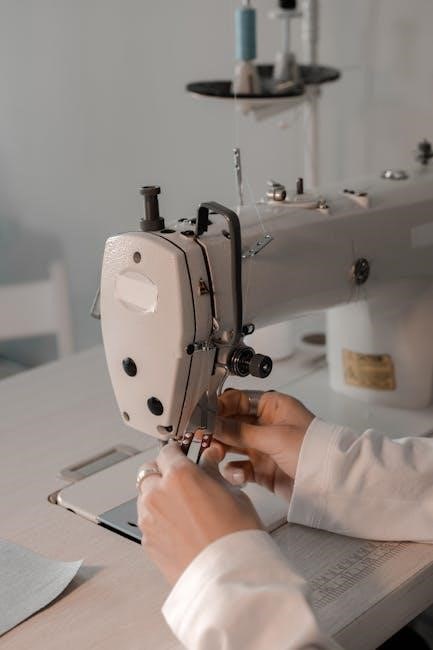
Maintenance and Troubleshooting
Regularly clean and lubricate the Singer 9410 to ensure smooth operation․ Refer to the manual for solutions to common issues like thread jams or needle breakage․ Proper care extends its lifespan and performance․
5․1 Cleaning and Lubricating the Machine
Regular cleaning and lubrication are essential to maintain the Singer 9410’s performance․ Turn off and unplug the machine before starting․ Remove any fabric, threads, or accessories․ Use a soft brush to sweep away lint and debris from the bobbin area, tension discs, and stitch plate․ Compressed air can also be used to remove dust․ Apply a few drops of sewing machine oil to the bobbin hook and other moving parts as indicated in the manual․ Avoid over-lubricating, as excess oil can attract dust․ After cleaning, gently wipe the machine with a dry cloth․ Regular maintenance ensures smooth operation and prevents mechanical issues․ Always refer to the manual for specific lubrication points and guidelines․
5․2 Common Issues and Solutions
Like any sewing machine, the Singer 9410 may encounter occasional issues․ Thread bunching or breaking often results from incorrect tension settings or misaligned threads․ Adjust the tension discs and ensure proper threading․ If the machine does not power on, check the power cord connection, ensure it is plugged into a working outlet, and verify the power switch is functioning․ Poor stitch quality may stem from a dull or incorrect needle type; replace the needle with one suitable for your fabric․ Fabric not feeding smoothly could indicate dirty or misaligned feed dogs; clean and check their position․ For persistent issues, consult the manual or contact Singer support․ Regular maintenance and proper handling can prevent many of these problems, ensuring smooth and efficient sewing․

Accessories and Optional Equipment
The Singer 9410 comes with essential accessories like various presser feet and a storage case․ Optional equipment includes specialized feet and needles, enhancing your sewing capabilities․
6․1 Understanding the Included Accessories
The Singer 9410 sewing machine comes with a variety of included accessories to enhance your sewing experience․ These include multiple presser feet, such as the All-Purpose Foot, Zipper Foot, and Buttonhole Foot, designed for specific tasks․ Additionally, you’ll find bobbins, needles, and a dust cover to protect your machine when not in use․ A sewing machine needle pack and a small screwdriver for adjustments are also provided․ These accessories are stored in a convenient case, keeping everything organized․ Understanding each accessory’s purpose will help you utilize the machine’s full potential․ Always refer to the manual for guidance on using and maintaining these included items to ensure optimal performance and longevity of your Singer 9410․
6․2 Recommended Optional Accessories for Enhanced Sewing
To further enhance your sewing experience with the Singer 9410, consider investing in optional accessories․ A sewing cart or extension table provides additional workspace, making large projects easier to manage․ Specialized presser feet, such as a quilting foot or an embroidery foot, can expand your creative possibilities․ Optional needle packs, like heavy-duty or twin needles, are ideal for thicker fabrics or decorative stitching․ A walking foot or Teflon foot can help with smooth fabric feeding․ Additionally, a sewing machine cover or carrying case offers protection during storage or transport․ These accessories are available through Singer or compatible third-party brands․ Exploring these options can tailor your machine to your specific sewing needs, ensuring a more efficient and enjoyable sewing process․
Mastering the Singer 9410 empowers you to create with confidence and precision․ This manual has guided you through its features, operation, and care․ Sew with passion and enjoy the machine’s reliability!
7․1 Final Tips for Getting the Most Out of Your Singer 9410
To maximize your Singer 9410’s potential, always maintain it regularly, experiment with its stitches, and use high-quality fabrics․ Keep your workspace organized and ensure proper lighting for precision․ Store the machine in a dry, clean area when not in use․ Explore the included accessories to enhance your sewing experience․ Refer to this manual for troubleshooting and maintenance tips․ Practice on scrap fabric before working on important projects․ Stay creative and enjoy the versatility of your Singer 9410․ Happy sewing!
